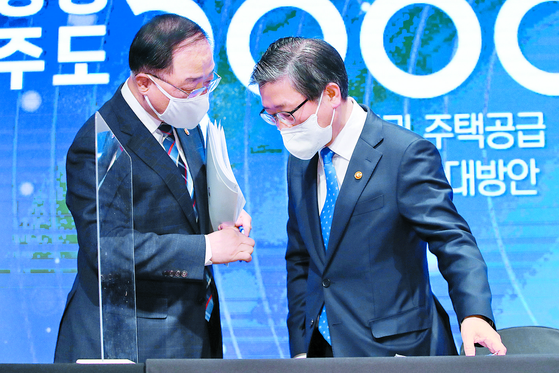![The government announced its 25th real estate countermeasure on the 4th and announced that it will supply 830,000 homes nationwide, including 320,000 homes in Seoul, under the public initiative by 2025. On the morning of the morning, Deputy Prime Minister Hong Nam-ki (left) and Minister of Land, Infrastructure and Transport Byun Chang-heum talked after announcing measures at the annex of the Seoul Government Complex. [사진공동취재단]](https://i0.wp.com/pds.joins.com/news/component/htmlphoto_mmdata/202102/05/8d64f238-ba58-4e53-a009-8d0e70f11c3d.jpg?w=560&ssl=1)
The government announced its 25th real estate countermeasure on the 4th and announced that it will supply 830,000 homes nationwide, including 320,000 homes in Seoul, under the public initiative by 2025. On the morning of the morning, Deputy Prime Minister Hong Nam-ki (left) and Minister of Land, Infrastructure and Transport Byun Chang-heum talked after announcing measures at the annex of the Seoul Government Complex. [사진공동취재단]
The core of the Moon Jae-in administration’s 25th real estate measure is’public initiative’. The government is planning to supply 836,000 new homes to Seoul, the metropolitan area, and local metropolitan areas by 2025. There is a willingness to change the housing supply market led by the private sector to a public initiative.
Transition to public when private supply to the city center is difficult
Increase the floor area ratio and ease the right to sunlight
Project proceeds with the consent of two-thirds of the landlord
Maintenance business expected to be shortened from 13 to 5 years
On the 4th, the government announced a plan to expand publicly led 3080+ housing supply in metropolitan areas at the government building in Seoul. According to this plan, by 2025, a total of 836,000 new households will be supplied to Seoul, including 320,000 households, 616,000 households in the metropolitan area, and 220,000 households in the five metropolitan cities. The total supply plan for the metropolitan area (1.27 million households), which is being promoted through the existing 3rd new city, is more than 2 million households, the highest level of the previous government. The government put out the merit of preventing monopoly of development profits and speeding up business progress if public enterprises lead.
The government-led urban development is largely in two directions. It is an urban public housing complex project that utilizes station areas, semi-industrial areas (more than 5000㎡) and low-rise residential areas (more than 10,000㎡), and maintenance projects in areas where a cooperative has been established or is being prepared.
For the urban development project, which will supply 117,000 households in Seoul alone for five years, a public institution secures land and starts the project with the consent of the owner. Simplified the owner agreement process to speed up the business. When public institutions such as Korea Land and Housing Corporation (LH) and Seoul Housing and Urban Corporation (SH) review the appropriateness of the project and request a district designation from the Ministry of Land, Infrastructure and Transport, within one year, two-thirds of the land owners ) To proceed with the project. If the private sector proceeds, the maintenance project must be agreed upon by more than three-quarters of the owners. Licensing and permits that take time are also reviewed by local governments. The project is carried out while the land is owned by the public, so there is less risk of business interruption.
Regulations are also relaxed. For high-density development in station areas, semi-industrial areas, and low-rise residential areas, the floor area ratio has been increased to a maximum of 700% in the case of station areas, and the sunlight and mining standards have been lowered. The floor area ratio, donations and payment ratio is also fixed at 15%, and this amount is used not only for public leases, but also for public private housing and public shopping centers.
The government plans to provide land owners with 10-30%p higher returns than before and additional profits such as preferentially supplying apartments and shopping malls. It is also preparing customized measures such as supplying public self-owned housing or loan support to landowners, tenants and small merchants who have insufficient burden capacity.
The redevelopment and reconstruction maintenance projects are also conducted by the public. In fact, the government takes over the role of the existing union. Public maintenance projects can be carried out at the request of a majority of members, and these projects are exempt from the reconstruction excess profit return system and the obligation to live for two years. The floor area ratio can be raised to the level 1, or up to 120% of the legal maximum floor area ratio. Existing maintenance sites can also be changed to public direct implementation if members wish. According to the government’s explanation, the general assembly of the union or the procedure for approving administrative dispositions is omitted, and the maintenance project that took more than 13 years can be completed within five years. However, Kim Deok-rye, head of the Housing Industry Research Institute’s Housing Policy Research Department, pointed out, “Even if it is implemented by the public, it is a difficult model to succeed unless the private sector such as residents actively participate.”
Reporter Kim Won [email protected]
